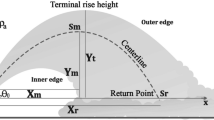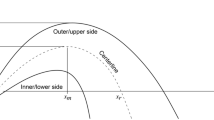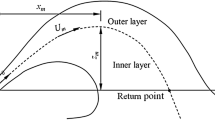Abstract
This paper aims to provide a more detailed representation of the scalar flux modeling (SFM) approach for modeling turbulent inclined negatively buoyant jets. The SFM approach addresses the limitations of eddy viscosity models in terms of the mean concentration field and turbulent scalar flux within the context of Reynolds-averaged Navier–Stokes modeling. In this study, the contribution of the involved terms in the transport equation of the turbulent scalar flux vector was evaluated, and the geometrical and mixing parameters of concentration and velocity of 45\(^\circ\) inclined negatively buoyant jets were verified. The SFM approach, along with the required modification for momentum flux modeling, was implemented in OpenFOAM v6. Results showed that the SFM approach can accurately predict mixing parameters due to the complex interactions between different turbulence contributors of the flow involved in the model. In comparison to simpler approaches, such as gradient-type models, that only correlate the gradient of the scalar field with turbulence, the SFM approach’s capability to predict mixing parameters is significantly higher.
















Similar content being viewed by others
Data availibility
The datasets generated during and/or analyzed during the current study are available from the corresponding author on reasonable request.
Abbreviations
- \(\mathbf {b_{ij}}\) :
-
Reynolds stress anisotropy
- \({\textbf {D}}\) :
-
Nozzle diameter
- \({\textbf {Fr}}\) :
-
Densimetric Froude number
- \(\mathbf {G/G_{ij}}\) :
-
Buoyancy production
- \({\textbf {g}}\) :
-
Gravitational acceleration
- \({\textbf {k}}\) :
-
Turbulent kinetic energy
- \(\mathbf {P/P_{ij}}\) :
-
Pressure/stress production
- R :
-
Ratio of dynamic to scalar time scales
- S :
-
Salinity
- \(\mathbf {Sc_{t}}\) :
-
Turbulent Schmidt number
- \(\mathbf {S_m}\) :
-
Centerline peak dilution ratio
- \(\mathbf {S_r}\) :
-
Return point dilution ratio
- \(\mathbf {\overline{S}_{ij}}\) :
-
Mean strain rate
- \(\varvec{S_\phi }\) :
-
Source term
- \(\mathbf {U_0}\) :
-
Initial jet velocity
- \(\mathbf {\overline{u'_i u'_j}}\) :
-
Reynolds stress tensor
- \(\mathbf {\overline{u'_i \phi '}}\) :
-
Reynolds flux vector
- \(\mathbf {\overline{W_{ij}}}\) :
-
Mean rate of rotation tensor
- \(\mathbf {X_m}\) :
-
Horizontal distance of the centerline peak to the origin
- \(\mathbf {X_r}\) :
-
Horizontal distance of the return point to the origin
- \(\mathbf {Y_m}\) :
-
Vertical distance of the centerline peak to the origin
- \(\mathbf {Y_t}\) :
-
Terminal rise height
- \(\varvec{\beta }\) :
-
Saline contraction coefficient
- \(\varvec{\Gamma }\) :
-
Molecular diffusivity
- \(\varvec{\delta }\) :
-
Kronecker delta
- \(\varvec{\epsilon , \epsilon _\phi }\) :
-
Dissipation rate of turbulent kinetic energy
- \(\varvec{\nu }\) :
-
Molecular viscosity
- \(\varvec{\nu _t}\) :
-
Eddy viscosity
- \(\varvec{\Pi _{ij}}\) :
-
Pressure-strain correlation
- \(\varvec{\pi _{i\phi }}\) :
-
Pressure-scalar correlation
- \(\varvec{\rho _0}\) :
-
Jet density
- \(\varvec{\rho _a, \rho _r}\) :
-
Water density
- \(\varvec{\tau _{ij}}\) :
-
Stress tensor
- \(\varvec{\Phi }\) :
-
Scalar quantity, mean scalar quantity
- \(\varvec{\phi '}\) :
-
Scalar fluctuation
References
Roberts PJ, Salas HJ, Reiff FM, Libhaber M, Labbe A, Thomson JC (2010) Marine wastewater outfalls and treatment systems
Roberts PJ, Ferrier A, Daviero G (1997) Mixing in inclined dense jets. J Hydraul Eng 123(8):693–699
Zeitoun M, Reid R, McHilhenny W, Mitchell T (1972) Model studies of outfall systems for desalination plants. Office of Saline Water, US Department of the Interior, Washington DC
Pincince AB, List EJ (1973) Disposal of brine into an estuary. J Water Pollut Control Fed 1:2335–44
Cipollina A, Brucato A, Grisafi F, Nicosia S (2005) Bench-scale investigation of inclined dense jets. J Hydraul Eng 131(11):1017–1022
Kikkert GA, Davidson M, Nokes R (2007) Inclined negatively buoyant discharges. J Hydraul Eng 133(5):545–554
Papakonstantis IG, Christodoulou GC, Papanicolaou PN (2011) Inclined negatively buoyant jets 1: geometrical characteristics. J Hydraul Res 49(1):3–12
Papakonstantis IG, Christodoulou GC, Papanicolaou PN (2011) Inclined negatively buoyant jets 2: concentration measurements. J Hydraul Res 49(1):13–22
Shao D, Law AW-K (2010) Mixing and boundary interactions of 30 and 45 inclined dense jets. Environ Fluid Mech 10(5):521–553
Lai CC, Lee JH (2012) Mixing of inclined dense jets in stationary ambient. J Hydro Environ Res 6(1):9–28
Oliver C, Davidson M, Nokes R (2013) Removing the boundary influence on negatively buoyant jets. Environ Fluid Mech 13(6):625–648
Oliver C (2012) Near field mixing of negatively buoyant jets
Bashitialshaaer R, Larson M, Persson KM (2012) An experimental investigation on inclined negatively buoyant jets. Water 4(3):720–738
Jiang B, Law AW-K, Lee JH-W (2013) Mixing of 30 and 45 inclined dense jets in shallow coastal waters. J Hydraul Eng 140(3):241–253
Abessi O, Roberts PJ (2015) Effect of nozzle orientation on dense jets in stagnant environments. J Hydraul Eng 141(8):06015009
Abessi O, Roberts PJ (2015) Effect of nozzle orientation on dense jets in stagnant environments. J Hydraul Eng 141(8):06015009
Crowe A, Davidson M, Nokes R (2016) Velocity measurements in inclined negatively buoyant jets. Environ Fluid Mech 16(3):503–520
Abessi O, Roberts PJ (2015) Dense jet discharges in shallow water. J Hydraul Eng 142(1):04015033
Papakonstantis IG, Tsatsara EI (2018) Trajectory characteristics of inclined turbulent dense jets. Environ Process 5(3):539–554
Papakonstantis IG, Tsatsara EI (2019) Mixing characteristics of inclined turbulent dense jets. Environ Process 6(2):525–541
Crowe AT (2013) Inclined negatively buoyant jets and boundary interaction. Ph.D. thesis, University of Canterbury
Tahmooresi S, Ahmadyar D (2022) Application of Reynolds flux modeling in CFD simulation of 45\(^\circ\) inclined negatively buoyant jets. Environ Fluid Mech 1:55–86
Mohammadian A, Gildeh HK, Nistor I (2020) CFD modeling of effluent discharges: a review of past numerical studies. Water 12(3):856
Doneker RL, Jirka GH (2007) Cormix user manual: a hydrodynamic mixing zone model and decision support system for pollutant discharges into surface waters. US Environmental Protection Agency, Washington DC
Robinson D, Wood M, Piggott M, Gorman G (2016) Cfd modelling of marine discharge mixing and dispersion. J Appl Water Eng Res 4(2):152–162
Papakonstantis IG, Christodoulou GC (2020) Simplified modelling of inclined turbulent dense jets. Fluids 5(4):204
Crowe A, Davidson M, Nokes R (2016) Modified reduced buoyancy flux model for desalination discharges. Desalination 378:53–59
Morton B, Taylor GI, Turner JS (1956) Turbulent gravitational convection from maintained and instantaneous sources. Proc R Soc Lond Ser A Math Phys Sci 234(1196):1–23
Fan LN (1967) Turbulent buoyant jets into stratified or flowing ambient fluids
Wang H, Law AW-k (2002) Second-order integral model for a round turbulent buoyant jet. J Fluid Mech 459:397–428
Jirka GH (2004) Integral model for turbulent buoyant jets in unbounded stratified flows part i: single round jet. Environ Fluid Mech 4(1):1–56
Yannopoulos P (2006) An improved integral model for plane and round turbulent buoyant jets. J Fluid Mech 547:267–296
Oliver C, Davidson M, Nokes R (2013) Predicting the near-field mixing of desalination discharges in a stationary environment. Desalination 309:148–155
Yannopoulos P, Bloutsos A (2012) Escaping mass approach for inclined plane and round buoyant jets. J Fluid Mech 695:81–111
Bloutsos AA, Yannopoulos PC (2020) Revisiting mean flow and mixing properties of negatively round buoyant jets using the escaping mass approach (EMA). Fluids 5(3):131
Papakonstantis IG, Papanicolaou PN (2022) On the computational modeling of inclined brine discharges. Fluids 7(2):86
Jirka GH (2008) Improved discharge configurations for brine effluents from desalination plants. J Hydraul Eng 134(1):116–120
Vafeiadou P, Papakonstantis I, Christodoulou G (2005) Numerical simulation of inclined negatively buoyant jets. In: The 9th international conference on environmental science and technology, September, pp 1–3
Oliver C, Davidson M, Nokes R (2008) k-\(\varepsilon\) predictions of the initial mixing of desalination discharges. Environ Fluid Mech 8(5–6):617
Kheirkhah Gildeh H, Mohammadian A, Nistor I, Qiblawey H, Yan X (2015) CFD modeling and analysis of the behavior of 30 and 45 inclined dense jets-new numerical insights. J Appl Water Eng Res 4(2):112–127
Kheirkhah Gildeh H, Mohammadian A, Nistor I, Qiblawey H (2015) Numerical modeling of 30 and 45 degree inclined dense turbulent jets in stationary ambient. Environ Fluid Mech 15(3):537–562
Tahmooresi S, Ahmadyar D (2021) Effects of turbulent Schmidt number on CFD simulation of 45\(^\circ\) inclined negatively buoyant jets. Environ Fluid Mech 21(1):39–62
Ramezani M, Abessi O, Firoozjaee AR (2021) Effect of proximity to bed on 30\(^\circ\) and 45\(^\circ\) inclined dense jets: a numerical study
Zhang S, Jiang B, Law AW-K, Zhao B (2015) Large eddy simulations of 45 inclined dense jets. Environ Fluid Mech 16(1):101–121
Zhang S, Law AW-K, Jiang M (2017) Large eddy simulations of 45 and 60 inclined dense jets with bottom impact. J Hydro Environ Res 15:54–66
Jiang M, Law AW-K, Lai AC (2019) Turbulence characteristics of 45 inclined dense jets. Environ Fluid Mech 19(1):27–54
Jiang M, Law AW-K, Song J (2019) Mixing characteristics of inclined dense jets with different nozzle geometries. J Hydro Environ Res 27:116–128
Jiang M, Law AW-K (2018) Mixing of swirling inclined dense jets—a numerical study. J Hydro Environ Res 21:118–130
Vafa N, Azadi A, Firoozabadi B (2021) Effect of numerical schemes on advection terms for large eddy simulation of inclined dense jets. Environ Fluid Mech 21:1227–52
Palomar P, Lara J, Losada I (2012) Near field brine discharge modeling part 2: validation of commercial tools. Desalination 290:28–42
Rodi W (1980) Turbulence models and their application in hydraulics. Germany: University of Karlsruhe,
Millero FJ, Poisson A (1981) International one-atmosphere equation of state of seawater. Deep Sea Re Part A Oceanogr Res Pap 28(6):625–629
Younis BA, Speziale CG, Clark TT (2005) A rational model for the turbulent scalar fluxes. Proc R Soc A Math Phys Eng Sci 461(2054):575–594
Batchelor G (1949) Diffusion in a field of homogeneous turbulence i. Eulerian analysis. Aust J Chem 2(4):437–450
Daly BJ, Harlow FH (1970) Transport equations in turbulence. Phys Fluids 13(11):2634–2649
Hanjalić K, Launder B (2011) Modelling turbulence in engineering and the environment: second-moment routes to closure. Cambridge University Press, Cambridge
Launder B (1976) Heat and mass transport, chapter 6 in turbulence, ed. by p. bradshaw. Topics in Applied Physics 12
Launder B (1989) The prediction of force field effects on turbulent shear flows via second-moment closure. In: Advances in turbulence 2, pp. 338–358. Springer
Hossain M, Rodi W (1982) A turbulence model for buoyant flows and its application to vertical buoyant jets. In: Turbulent buoyant jets and plumes, pp 121–178. Elsevier
Monin A (1965) On the symmetry properties of turbulence in the surface layer of air. Isv Atmos Ocean Phys 1:45–54
Launder B (1975) On the effects of a gravitational field on the turbulent transport of heat and momentum. J Fluid Mech 67(3):569–581
Gibson M, Launder B (1978) Ground effects on pressure fluctuations in the atmospheric boundary layer. J Fluid Mech 86(3):491–511
Gibson M, Launder B (1976) On the calculation of horizontal nonequilibrium turbulent shear flows under gravitational influence. J Heat Trans 98:81–87
Speziale CG, Sarkar S, Gatski TB (1991) Modelling the pressure-strain correlation of turbulence: an invariant dynamical systems approach. J Fluid Mech 227:245–272
Greenshields CJ (2018) Openfoam user guide version 6. The OpenFOAM Foundation 237
Roberts PJ, Toms G (1987) Inclined dense jets in flowing current. J Hydraul Eng 113(3):323–340
Malin M, Younis B (1990) Calculation of turbulent Buoyant plumes with a Reynolds stress and heat flux transport closure. Int J Heat Mass Transf 33(10):2247–2264
Shao D, Law AW-K (2009) Turbulent mass and momentum transport of a circular offset dense jet. J Turbul 10(10):40
Cresswell R, Szczepura R (1993) Experimental investigation into a turbulent jet with negative buoyancy. Phys Fluids A 5(11):2865–2878
Acknowledgements
This research was enabled in part by support provided by WestGrid (www.westgrid.ca) and Compute Canada Calcul Canada (www.computecanada.ca).
Funding
The authors have no relevant financial or non-financial interests to disclose.
Author information
Authors and Affiliations
Contributions
All authors whose names appear on the submission made substantial contributions to the conception or design of the work.
Corresponding author
Ethics declarations
Conflict of interest
The authors declare that they have no known competing financial interests or personal relationships that could have appeared to influence the work reported in this paper.
Additional information
Publisher's Note
Springer Nature remains neutral with regard to jurisdictional claims in published maps and institutional affiliations.
Rights and permissions
Springer Nature or its licensor (e.g. a society or other partner) holds exclusive rights to this article under a publishing agreement with the author(s) or other rightsholder(s); author self-archiving of the accepted manuscript version of this article is solely governed by the terms of such publishing agreement and applicable law.
About this article
Cite this article
Tahmooresi, S., Mohammadian, A., Nistor, I. et al. Reynolds flux modeling; new numerical insights into inclined dense jets. Environ Fluid Mech 23, 551–577 (2023). https://doi.org/10.1007/s10652-023-09919-z
Received:
Accepted:
Published:
Issue Date:
DOI: https://doi.org/10.1007/s10652-023-09919-z




